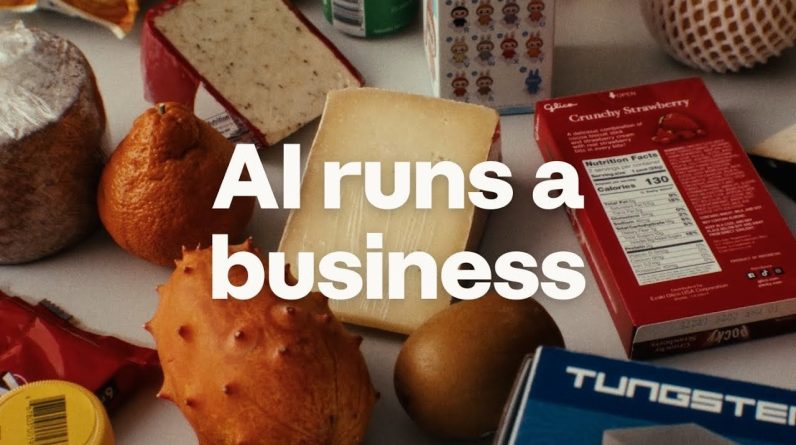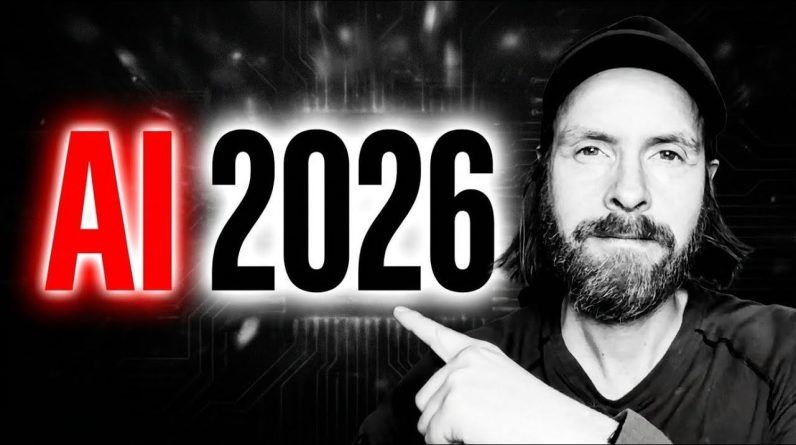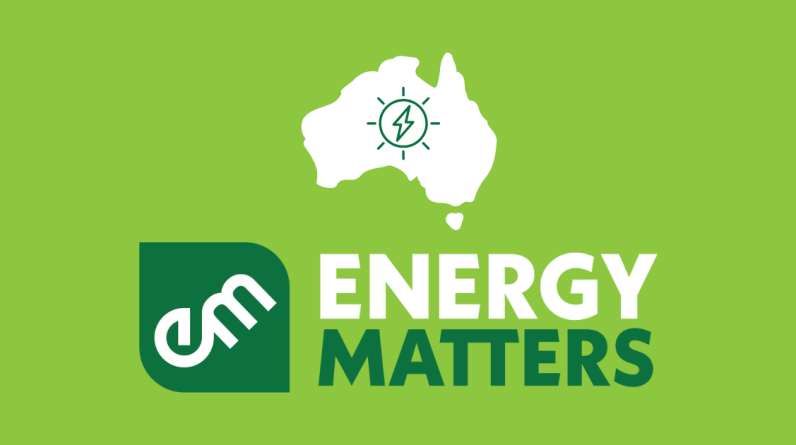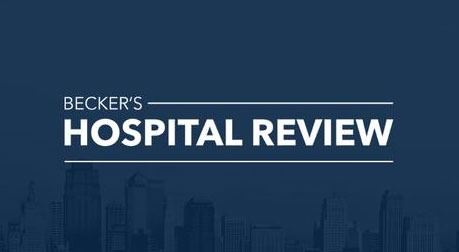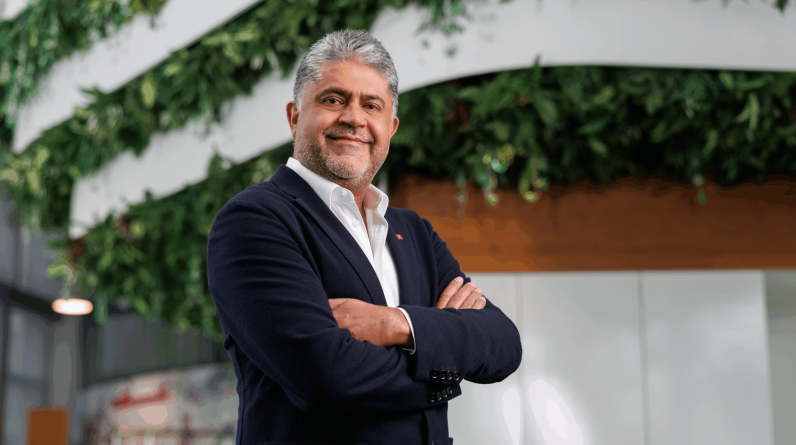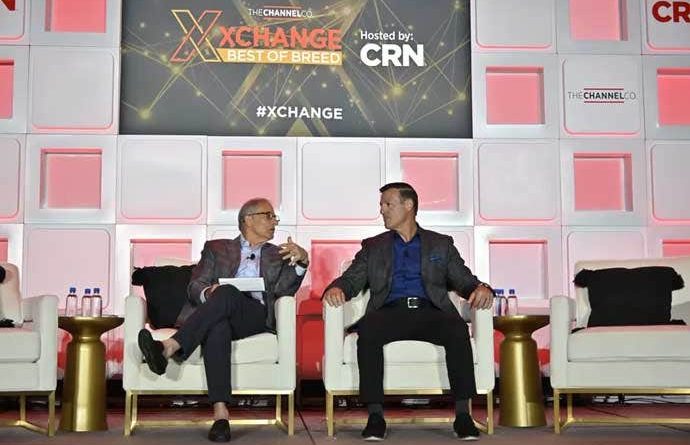
In a Q&A at the 2025 XChange Best Of Breed conference, Ingram Micro CEO Paul Bay said the distributorâs efforts, including expanding the use of AI for order processing, are focused on operational efficiencies and improving services for the channel, allowing solution providers more time to understand their customersâ needs and create value.
Ingram Micro CEO Paul Bay says the distributor and its channel partners spend too much time âtalking internallyââincluding the time spent on processing ordersâwhen they should be talking to customers to help create value.
Bay, in a Q&A at this weekâs 2025 XChange Best of Breed event in Atlanta, hosted by CRN parent The Channel Company, said Ingram Micro is increasing its use of artificial intelligence throughout its order processing systems, including its Xvantage order processing system and the recently introduced Intelligent Digital Assistant, to streamline order taking and fulfillment.
And he urged solution provider executives in attendance to look closely at how much time they spend on their own internal processes versus value-generating interactions with customers.
âI would ask all of you as business leaders, go back into your business [and] figure out the amount of time youâre spending internallyâwhich does nothing for that business outcome,â he said.
Bay (pictured, right) was engaged in the Q&A with Frank Vitagliano, a longtime IT channel executive who is now CEO of the Global Technology Distribution Council, an industry association dedicated to highlighting the role ofâand the value provided byâthe councilâs member distributors in the IT channel.
During the Q&A session, Bay talked about digital transformation and Ingram Microâs growing use of AI to automate order processing and other internal systems, his views on the state of the industry and the U.S. economy, the distributorâs relationships with the hyperscalers and their online marketplaces, and the recurring theme of the importance for solution providers to focus on generating value for their customers by developing services to meet their needs.
Bay also provided a personal account of the devastating ransomware attack that hit the distributor in July, how the company was able to get its systems back up and running so quickly, and the lessons he learned as a leader from the incident.
Here is more of Bayâs conversation with Vitagliano.

Letâs start at a macro level of what youâre seeing. There was some discussion yesterday by [IBM CEO] Arvind Krishna on his views on the global economy, what heâs seeing. There seems to be some consensus [on] mid- to high-single-digit growth for the IT industry, two or three points above GDP. There are so many things out there in terms of industry considerations. And you are managing a large public company ⦠what are you seeing?
Itâs an exciting time. Thereâs growthâtalking to partners, many of you in the room, and the opportunities. I look at the growth opportunities, value growth, and then capturing that value that we have in the market. Thereâs really four different ways weâre seeing it, talking to all of you, what we see in our business.
So the first thing is services. Partners are doubling down on the services that youâre all delivering. But I would say thereâs more questions and conversations weâre having around what services do you offer. ⦠Youâve got to be really good at what youâre doing. What are those services, your core services, that youâre doubling down on? How do we grow our services?
Another thing is operational efficiencies. When youâre looking at areas, whether itâs your professional services automation, your ticket automation, and then just internallyâwhat are you doing internally? I say this often, and itâs been pretty prevalent in our industry ⦠which is that we just spend a lot of time internally together and that does nothing for the outcome for those businesses, the millions of businesses youâre serving each and every day. What are you doing around operational efficiencies?
The other thing is AI, whatâs happening in AI. And weâll talk a little bit about that, what weâre seeing, what weâre doing. But what are you doing around AI and monetizing it? Thereâs this whole spending arms race thatâs going on that everybody sees, thatâs propping up the markets from a spend standpoint, everybodyâs spending and investing with each other. Thatâs really about the consumption of the data. But what are you doing around AI and really figuring out how to monetize that? And how are we using AI?
And the last thing is wraparound security. Security is at the front of everybodyâs mind. Iâm sure youâll ask me a question at some point about the unfortunate situation we had to deal with recently. We sat right in the middle of it.
So those are really the four things weâre seeing. But I would say the growth opportunity and value creation and value capture, as we sit in this great ecosystem that we have, is that thereâs an opportunity, both here in North America and on a global basis.

Ingram touches, probably, 90 percent of the worldâs population in terms of the number of customers that you deal with and, obviously, the number of vendors. What are you hearing, whatâs the sense you get, in terms of where we are as you look out through the rest of this year and through next year?
I think thereâs still going to be growth. Weâve seen growth, for us, through the first two quarters, weâre at 10 percent. So the growth opportunity ⦠whether itâs the refresh, kind of around security, thereâs a lot going on with hyperscale and cloud deployment.
And I think the opportunity that we all have because of the complexity of technology, business outcomes arenât solved just one way. Itâs not just with one vendor. Thereâs so many different ways to go after that. So again, itâs really understanding what business youâre in, where you have an opportunity to really provide good services to deliver those business outcomes.
Letâs talk about digital transformation. Youâre driving a major transformation of a business that has been in place for a long time. Just in terms of driving change within a massive organization, what does it take? What are you seeing, and what are some of the challenges youâre experiencing?
I would say mindset was the biggest thing. You donât know what youâre getting into. As you mentioned, weâve been in business for 46-plus years now, [gone] public twice. … As weâve gone through this journey, it wasnât like we were disrupting a company that wasnât successful from the beginning.
But if you take a step back, what was the opportunity? Weâre talking with all of you. When you put the customer in the middle, what were those challenges we were having? Again, I talked about how we spend so much time internally together just to get to that business outcome, as opposed to having a conversation [to] say, âWhereâs the opportunity ⦠to go talk to your customer?â Think about the hours that we spend as an ecosystem internally, doing the things that are important because they canât be solved from an automated perspective because of the large, vast ecosystem we sit in. How do we free up that time to go out and have that business conversation and try to get a different business outcome?

When we talk about AI, the impact itâs going to have, [IBMâs] Krishna said weâre kind of in the first inning and thereâs still a long way to go. But what is happening, there are processes that are being transformed on a regular basis. â¦IDC did some research that indicated the investment from the channel, solution providers ⦠was kind of spotty, kind of inconsistent. They noted that while some were racing ahead, there were others that were staying the course.
So two questions for you here: One is, as part of Xvantage, you recently introduced the IDA intelligent digital assistant. Can you describe that? And can you also talk a little bit about channel partners and what you see them doing in terms of successfully [applying] AI to their business?
Again, when you [focus on] the customer to really understand what those challenges are and the opportunities we have, it was really around three areas.
The first was really about friction and the cost to serve. And Iâll give you a couple examples on that cost to serve. We receive over a million emails, still, from partners on orders, as opposed to coming through the electronic [ordering system]. So weâve created through some of our AI models, if we receive an email now it goes right into the Xvantage system ⦠and it responds right back to the customer, as opposed to emails that go back and forth. ⦠Weâd rather automate that process.
Email to order is just one example. Another is order status and tracking: 2.4 million requests we get just in the U.S., emails, phone calls to say, âHey, can you tell me my order status?â Again, six different products, services, come from six different vendors. How do we automate that? So we did that and we created a single pane of glass. We took it off our $600 million investment that we made in cloud over the last dozen years and that was the foundation for Xvantage for us to be able to build on.
One of the key things was, how do we take the very fragmented business-to-business industry that weâre in and make it very business-to-consumer friendly? So you come on Xvantage and youâll be able to see order status, be able to track it. … Bringing that complexity together with the 1,500 vendors that we [work with], through all the different carriers, through all the different interactions that we have, weâve created a model to [manage] that. Thatâs the first case that weâre really going to focus on, reducing the cost to serve both internally and with all of you, so we can free up time.
The second phase in this is really around go-to-market. How do we accelerate go-to-market and spend time on demand generation for all of you, because thatâs one of the single biggest things we can get responses from. You get it too from a GTDC standpoint when you talk to customers and vendors, which is, âHow do we go generate more demand?â
So weâre doing it in a number of different ways. One is what we call âIDA,â intelligent digital assistant … and weâre actually able to accelerate and shorten the sales cycle. What we do is weâre able to take that informationâyou provide a code to usâand [an order] comes in, and we are now proactively freeing up the time those [Ingram Micro] people used to do order status checking. Now we call you and say, âBased on the data that we have from one of our models,â that we created with AI ⦠we can say this end customer youâre calling on has a propensity to actually acquire technology ⦠in the next seven days, as opposed to everybody waiting until the quarter ends to start dialing for dollars. ⦠So weâve really shortened those sales cycles.â
The data shows for just Q2 alone we had tens of thousands of opportunities that came in, which equated to hundreds of millions of dollars. And thatâs part of our growth, because again, we mentioned weâre growing around 10 percent year to date for Q1 and Q2 and a lot of that is because weâre being proactive now.
And then the third one, really for us, is just around using data insights. When I say I want to be a platform company, itâs how do we take data and the inbound [orders], touchless, immediately all the way through the demand, supply chain systems, all the way through the back end. Weâre still probably in theâdepending on which country youâre inâphase one of getting to efficient, how weâre getting to looking at the cost-of-serve, and getting to really starting to go outbound, demand generation, eventually getting to the data.
What does that mean for all of you? âThatâs great, Paul, youâre doing all these things internally, getting a couple of data points.â There are three things weâre going to help you drive: speed, scale and service.
Again, I would ask all of you as business leaders, go back into your business, figure out the amount of time youâre spending internallyâwhich does nothing for that business outcome. And it has to happen today because thereâs no way to be able to solve for, and thatâs what weâre really making our investments around, is to make it simple for you all to come to one spot, that single pane of glass, where you can actually now acquire hardware, software, services and cloud all in a single transaction.

Letâs change gears here for a minute and talk about security. A couple of weeks before the Fourth of July weekend you and I were texting back and forth over some business issues and you ended the text by saying, âHey, Iâm heading to Asia for a week and I canât wait to get back and take some time off during the Fourth of July weekend.â It didnât quite work out that way. [Ingram Micro] experienced a very significant ransomware attackâwhich Iâm sure everyone in this room knows. Talk a little bit about that, the lessons learned from that, as much as you can share with us.
Yeah, itâs under investigation, ongoing, and [I am restricted on what I can disclose]. And youâre right, I was in Asia for two weeks. I went to India, Singapore, Australia, and came back after a couple of weeks and got back on [July] 3rd I got a call on the 3rd that said there may be an issue. âIf something pops up, give me a shout.â
I got a call and, before you know it, board meetings on the Fourth of July weekend and the next couple of weeks were taken up, taken over. It was one of those things that you plan for. And you know, when youâre doing it, youâre saying âend-to-endâ and hereâs whatâs going to happen. The reality is when you get into a crisis situation, you really find out a lot.
I found out a lot about leadership, by the way. First and foremost, I would say, they need all of you in this room. ⦠I was so surprised at the amount of vendors and customer leadership that reached out to me with empathy and knowing that this is a challenge because youâre dealing with it on a daily basisâ¦
And so we look at it in a couple of different ways. And I think one of the successesâthereâs a couple of things that drove the success for usâwas getting back up so quickly. One was [we] took it as a business issue, not just a security issue. And so when we looked at it, we brought in people early morning out on the West Coast, early morning East Coast, evening West Coast, so we could touch the world. We brought in all the primary vendors ⦠we were working 24×7.
We looked at it and said, âThis is a business issue.â Knowing weâre still, you know, in a basis point business and a lower margin business, when we got our first assessment, they said itâs going to take weeks, if not months to [return to full operations]. We canât afford that, nor can you, nor can you in any business that is trusted and [customers] rely on.
And so we took [the position] âThatâs not going to happen. What do we need to do?â We scaled up some of the third-party expertise that we had, scaled up very quickly the partnerships that we had. And we looked at it and said, âFrom a business perspective, we do this and this happens. This is where we go. If we do this, this happens, go left to right. This is where we go.â It just kept happening over and over.
We were back up in a couple of days in the U.S. It was a handful of days around the rest of the world. And I remember sitting there, Sanjib Sahoo, who is our group president, runs the global platforms group for me, and we were on that first call in the morning, saying this is going to be weeks and weeks to get back up and get going. And he said, âWe donât have weeks. We got 24,000-plus mouths to feed at Ingram Micro. Plus, weâve got 160,000 partners and 1,500 vendors that rely on us. What do we need to do to shorten that cycle?â
And so the technology working with the business, being as proactive as we could. I mean, that was one of the challenges we had internally. I wanted to go out and talk to all of you and I did, when I could, get together and make sure we were communicating. But these are, you know, criminal activities that were going onâyou have to be careful and sensitive of what youâre communicating based on the processes.
But really looking at it from a business perspective, not just a technology issue, and bringing those two together, I think, allowed us to move much more quickly. In addition, back to the technology, the architecture matters, because of the way we were set up â¦from a more modular standpoint. With that advantage, we could start ⦠turning things back on in a much more seamless way, because we werenât just tied to the ERP legacy [system]. ERPs are the things we had to tinker with. So that allowed us to expedite [system recovery].
I hope you never have to go through it as a company. And if you do, and you need help … send me an email. Iâll make sure we get in contact. Weâve had a lot of questions from customers who helped create a playbook on what we did around that. I think thereâs some validation and some value that we can provide on what we learned through that process [at a] $50 billion company, a global company, and what worked.

So as you continue to expand your services, letâs talk about the hyperscalers for a minute. They obviously have a significant presence in this space. For a long period of time folks [have been] talking about the disintermediation of distributionâwhich hasnât happened. They have a very significant role. How do you see it and how are you working with them?
It was kind of like the cloud days when everybody was going to be disintermediated. ⦠Are they friend or foe? Are they frenemies? The answer is theyâre super critical in the technology thatâs being deployed today and will continue to be critical for the technology thatâs being deployed.
But I always go back to, theyâre just one piece of the solution. And we know itâs super important for all of you to maintain that relationship, the visibility, with the end user.
What weâre doing, weâre building some unique things around, one, weâve got the AWS gateway that weâve created from a connectivity perspective, where you go out to their marketplace and see their private offerings and actually order through us. Itâs part of the entire process, and you own that delivery from an end-to-end perspective.
Because one of the challenges that has been created by the hyperscalersâ [online marketplaces] is theyâre making commitments or end businesses are making commitments of spend that theyâre going to spend. And so as they want to bring that spend down from a rebate perspective, and quote, unquote, burn it down. Theyâre saying, âHereâs what I want to do,â and youâre stuck with sometimes, âHey, Iâve got to] go in this direction.â
So weâre trying to make that a seamless process where you can have that complete solution of third-party offerings that are on there, bring that together and own that from an end-to-end standpoint.
AWS is the first one we did it with. Weâll continue to build that out. And I think for all of the hyperscalers, the opportunity is super relevant in the technologies that youâre deploying. And so we want to make that, again, going back to simple, seamless and as touchless as possible, where you come in as the trusted adviser, really that business outcome, and youâre able to make that as seamless as possible for your businesses.

The interesting thing is, when you talk to the hyperscalers, they are at the point where they are looking to [expand] the distribution process. They all have people in place that are responsible for, and have supported, the distribution relationship. And I think thatâs significant.
And itâs going to continue to evolve. The conversation Iâm havingâgoing back to your opening questionâvendors want to do more with this channel. Youâve heard from many people that have already been on stage. Youâve seen Microsoft program changes Iâve been looking for. Why? Itâs because of the value you all are providing, and the opportunity that we have, collectively, to be able to do that.
The hyperscalers, [who] were a couple of cycles behind, are catching up to that. And they see the value of what you all do from an end business standpoint. They donât want to disintermediate you. What they want is the spend. And how they get the spend, theyâre seeing the value the channels [are] providing. And we think thatâs really what the opportunity is for, collectively, us to tell your stories and for us to make it as easy as possible to move forward.
I would say the conversations I have had over 30-plus years now in this industry, itâs not about disintermediation. Itâs about the value thatâs being provided by all of you.
So in closing, obviously, thereâs a room full of the biggest and best solution providers in, certainly North America, and leading vendors. Whatâs your message?
I think thereâs growth opportunities that we have out there. So letâs go capture that value, create the value and capture the valueâwhich are two different things. ⦠We love to have that opportunity to help, to be your partner. We appreciate your business and the opportunity.
Again, I think weâre in an exciting time and complexity drives opportunities for all of you and letâs keep moving forward together. So thanks for your partnership, and we appreciate what weâre doing together. And I think that from here on out thereâs going to be continued growth opportunities for all of us in the marketplace.


